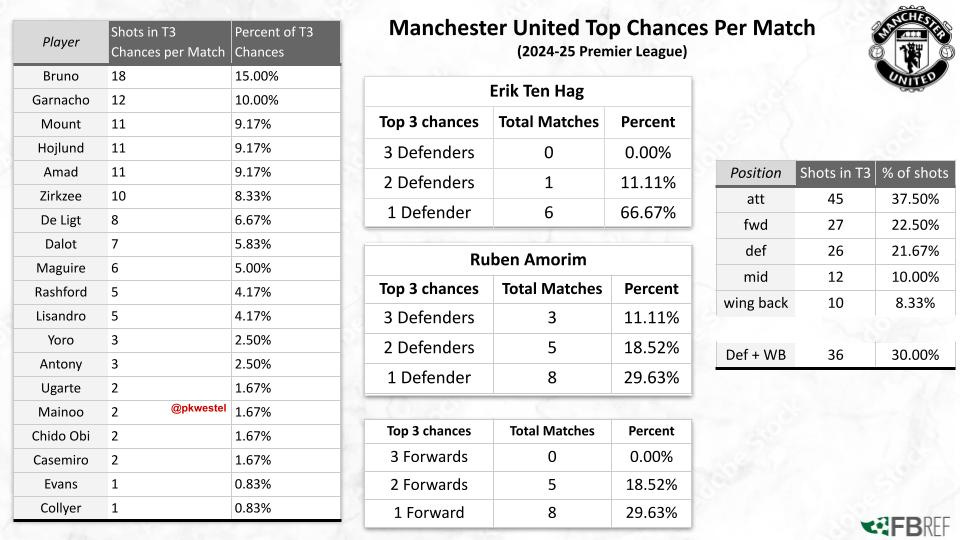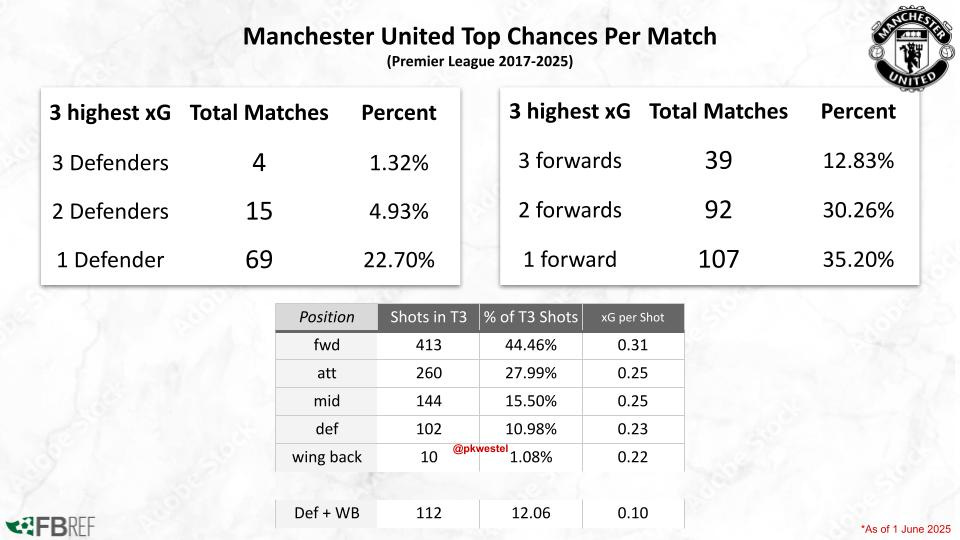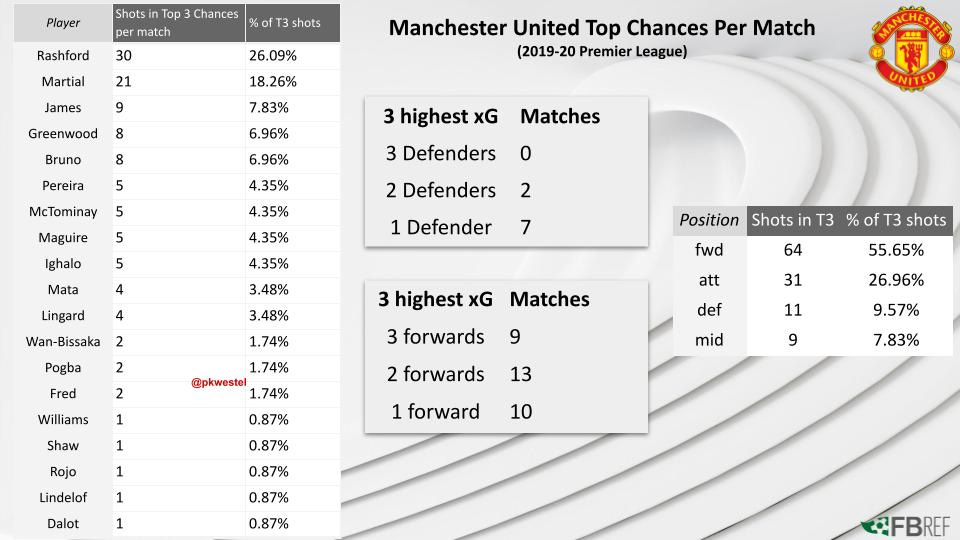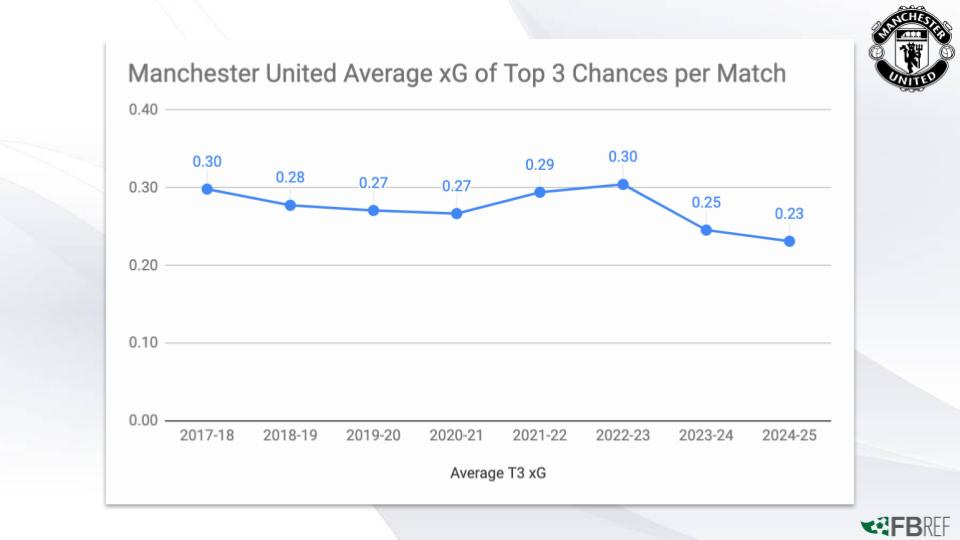Manchester United's xG underperformance Part II: Who is getting the best chances?
One reason for Man United's poor efficiency in front of goal last season? Their best chances kept falling to the wrong players
This Part II of exploring why Manchester United are underperforming their xG. Check out Part I here.
Let’s start with an inherent truth about football. Finishing is a skill. We may not know how to fully measure finishing due to the amount of variance around it but it exists.
We know this simply because players that can consistently put the ball into the net get put in the positions closest to the goal to take advantage of that skill.
This typically happens at the youth levels. The kids who score goals stay at forward, those who don’t get pushed further back on the pitch and develop at those positions. Earlier this year Harry Maguire detailed to the Athletic how as a kid he was first placed up top only to be progressively moved further back on the pitch.
Sometimes players make it to the top level only to then develop their scoring touch. When that happens, they get moved closer to goal! Thierry Henry, Robin van Persie, Pierre Emerick Aubameyang, and Cristiano Ronaldo all started their careers as wingers before being moved to more central forward positions. Gareth Bale and Bakayo Saka broke into senior football as fullbacks only to be pushed up into attacking players. Hell, Mikel Antonio was a right back who became a striker.
The opposite is true for people who don’t score. Players who come up as strikers first get moved out to wider positions. Wingers who aren’t good enough attackers - like Victor Moses, Antonio Valencia, and Ashley Young - become wing backs and fullbacks. Attacking midfielders like Paul Scholes, Steven Garrard, or Luka Modric extend their careers by dropping deeper and playing as holding midfielders. It’s football Darwinism.
In Part I of this series, we were looking at a Leny Yoro chance late in the game against Bournemouth. The shot had an xG value of 0.3 but I argued that given the context of who that chance was falling to you couldn’t expect it to be converted 30 percent of the time.
A few weeks later United went to Anfield and - after surprisingly having a 2-2 scoreline late in the game - had a chance to steal the match. In the 97th minute they created a chance worth 0.31 xG that fell to Harry Maguire, who skied it over the bar. On xG that was their best chance of the match.
Maguire would come up big in the 90th minute a month later in the FA Cup and he’d come up really big later in the season against Lyon, but ultimately Harry Maguire isn’t the guy you want getting on the end of a chance in the box like that. He’s not a goal scorer - if he was, he’d be a striker.
If that chance fell to Alexander Isak, Chris Wood - or even Anthony Martial or Marcus Rashford - you’d have high expectations of them putting it away (bouncing ball and all). They’re forwards/strikers, they’ve been in this situation many times before, they’ve dealt with bad passes, they’ve dealt with the pressure. How often is a center back getting on the end of a chance like this? How much experience does he have in finishing this off - especially if the pass isn’t perfect?
Who is getting on the end of chances matters. One of the things I’ve been harping about for the past two years was how United’s system seemed designed to consistently put Diogo Dalot in the most dangerous positions and on the end of their best chances.
This was a trend under Erik Ten Hag and it continued under Ruben Amorim.
By the Liverpool match in early January United had already scored five fewer goals than their expected goals total. I started wondering if there were some tactical issues behind this under performance? Were the tactical systems deployed by the managers leading to the best shots often going to the wrong people? Was this a weird coincidence or a misuse of the squad?
I continued to monitor this over the back half of the season. I wanted to see specifically who was getting United’s best chances in each game and was it skewing disproportionally high towards defenders?1
I went to Fbref and compiled a database of every shot United took this season. Then I took the three best chances from each match based on xG values - excluding penalties - to see who these chances were falling to2. I also grouped the players by position to cluster them together.
Here’s what we got.
What jumps off the page is the number of games that a defender had one of the ‘top three chances in a match’ (T3) - 23 times in 38 matches. When you combine the defenders and the wing backs, 30 percent of these T3 shots were taken by them. That jumps to 32 percent when you look at only the games managed by Amorim. Of those 10 shots taken by wingbacks, Amad only accounts for two of them.
On its own this data doesn’t tell us much. Maybe defenders often get the best chances because set pieces can yield very high xG chances? How does this compare with previous versions of United? Specifically how does it compare with the seasons where United over-performed their xG?
I went back as far as the Fbref database goes and added every Premier League shot United have taken since the 2017-18 season. Once again I compiled a list of the T3 chances United got in each game.
The players were grouped into four categories: defenders, midfielders, attackers, and forwards.
Attackers constitutes attacking midfielders - like Bruno, Mason Mount, and Juan Mata - and wingers. Forwards is meant to be more of your strikers. Players like Ronaldo, Edinson Cavani, and Romelu Lukaku easily fall into the forwards category but there’s gray area with wide players like Rashford or - at times - Anthony Martial or Alejandro Garnacho.
There’s certainly some subjectivity here but I drew the line at players who came up as strikers/center forwards vs players who have always just been wide players. Rashford, Martial, and Mason Greenwood were classed as forwards while the likes of Garnacho, Antony, Jadon Sancho, Dan James, and Amad fell into the attackers group. Alexis Sanchez was another difficult one in here but he ultimately got grouped with the forwards.
I should also note that for the T3 chances in each match - for Ruben Amorim I had a sub group of defenders for wing-backs. Wing back classifies the role the player was playing at the time of the shot but not the player himself. For example; Amad is an attacker who could have a shot as a wing back. Diogo Dalot is a defender who could have a shot as a wing-back.
Results
The first thing to notice is the difference in positional distribution from this past season compared to the last eight years. In 304 Premier League matches since 2017-18, there have been four times that United’s T3 chances in a match all came from defenders. Three of those occurred in the last 27 games!3
There have been 88 matches with at least one defender getting one of the T3 chances of the match - a bit more than a quarter of the matches. 23 of those 88 matches occurred this season with 16 coming under Ruben Amorim. That’s 18 percent of the matches where at least one defender had one of the three best chances occurring under a manager who was in charge for less than 9 percent of the total matches. It’s completely disproportional.
As I previously mentioned, I wanted to compare what we saw this season with the seasons where United over-performed their xG. Those three seasons are 2017-18, 2019-20, and 2020-21.
2017-18
Over a quarter of the best chances on a week to week basis going to your £75m striker is exactly what you want to see. Marcus Rashford and Anthony Martial also rank very high on the list despite their playing time dropping significantly over the second half of the season.
There’s a big pre-Alexis post-Alexis split on this season. 23 of Lukaku’s 31 shots on that list - along with 16 of Rashford and Martial’s combined 21 - came before Alexis arrived. Once Alexis arrived the rate of Pogba and Lingard popping up with big chances increased and five of the 10 matches where a defender had one of the three best chances in the game came in the 14 games after Alexis joined. United’s form tailed off as they stopped creating chances for their best players.
2019-20
The top four guys are the four guys who played across the front three - despite pretty limited minutes for Mason Greenwood. Number five is their best attacking midfielder. Five defenders rounding out the bottom is indicative of how many players United had to use early in the season when they were decimated by injuries and they really struggled for form.
2020-21
Again the top five spots are taken by the guys who played in the most attacking four positions. When building this dataset what stood out to me from 2019-21 wasn’t just how often I was seeing some combination of Martial and Rashford with the T3 chances but how often numbers four, five, and even six also went to Martial and Rashford.
These guys weren’t high shot volume guys either. They were both under three shots per 90 during those seasons. The knock on Martial was his poor movement preventing him from getting too many scoring chances. Martial specifically had a really poor season in 2020-21. Despite all that the pair were consistently getting the best chances. Hell, Odion Ighalo popped up on that list five times and he only played 101 minutes!
Those teams knew how to get the ball to their goal scorers. The biggest discrepancies in terms of other names popping up came when certain other players got injured. The depth just wasn’t there. United’s issue over those two seasons wasn’t that they were squandering chances because their forwards weren’t good enough. Their issue was that they weren’t creating enough of those chances.
Getting the ball to your best players seems to be a solid recipe for out performing your xG. Scoring goals is really difficult. Your best players are going to miss seemingly can’t miss opportunities. But if they are the ones consistently getting on the end of the best chances, they should score enough to balance out the xG. Then when the rest of the squad pop up with lower quality chances and occasionally put one in the net - you’ll out perform that xG. It also seems to be a good recipe for winning games.
Take a look at United’s record broken down by how often their top three chances in a match fall to their forwards:
Record Wins Draw Loss Win Rate PPM
3 Forwards 24 8 7 61.54%. 2.05
2 Forwards 49 19 24 53.26%. 1.80
1 Forward 54 27 26 50.47%. 1.77
0 Forwards 23 18 24 35.38%. 1.34
There isn’t much of a difference between one forward or two but there’s a significant difference between all three chances falling to forwards and only two. Then there’s a big difference between only one chance vs none.
That’s not to say that all these chances were converted into goals, that other things aren’t impacting the final score4, or that the three best chances of the match are always good chances. There were matches where United’s best chance had an xG value of just 0.08, which isn’t good at all. There were matches where the three forwards missed the three best chances and they won 1-0 when someone else scored a low percentage chance.
But this isn’t rocket science - the guys who are most adept at putting the ball into the net are your forwards. The name of the game is to get them the ball in the most dangerous positions as often as you can.
Over the last two years there’s been an increase in defenders getting one of their three best chances. This has coincided with the average xG of their T3 chances per match falling the past two seasons.
There’s something fundamentally wrong when your biggest chances are as disproportionally skewed towards defenders as they were in 2024-25. The question is, what is it?
Stay tuned for Part III
Sure enough, that Liverpool match was the fourth straight match that United’s best chance went to a defender
If there was a tie for third place, I put both on the list so long as they were over 0.05 xG
The fourth was United’s loss at home to Fulham in 2023-24
Such as David de Gea being super human in 2017-18. There are a lot of different factors that lead to United winning games













Excellent. It's clear that you've done a lot of work on this.
United have lost their way over the last couple of seasons. I have my own ideas why but I don't want to prompt part three.